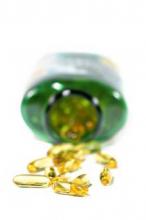Two years of vitamin D supplementation at a dose high enough to raise 25-hydroxyvitamin D plasma levels to more than 36 ng/mL failed to reduce knee pain or stem the loss of cartilage volume in patients with knee osteoarthritis, according to a report published Jan. 9 in JAMA.
These results from a single-center, randomized, double-blind, controlled clinical trial, taken together with recent observational data, indicate that vitamin D does not have a major effect on knee OA symptoms or progression among patients who already have sufficient vitamin D intake, said Dr. Timothy McAlindon of the division of rheumatology at Tufts Medical Center, Boston, and his associates.
The investigators conducted the trial because vitamin D is known to influence bone health, and some epidemiologic studies have suggested that the progression of OA is slower in patients with higher plasma levels of 25-hydroxyvitamin D. They enrolled patients aged 45 years and older who had symptomatic knee OA and at least one osteophyte on radiography, including some with KL grade 4 knee OA indicating severe structural damage.
The 146 study subjects were randomly assigned in a double-blind fashion to receive either cholecalciferol capsules (73 patients) or identical placebo capsules (73 patients) for 2 years. The initial dose of active vitamin D was 2,000 IU daily and was adjusted at 4-month intervals to achieve a target 25-hydroxyvitamin D plasma level of 36-100 ng/mL. This is the level at which epidemiologic studies have reported that vitamin D may have an effect on OA.
The study subjects were monitored for the development of hypercalcemia, hypercalciuria, and hypervitaminosis D. They underwent regular clinical assessments as well as knee radiography at baseline and at 2 years; knee and hip dual x-ray absorptiometry; and MRI scanning of the affected knee at baseline, 12 months, and 24 months to assess cartilage volume loss.
The study subjects kept pill diaries, and pill counts were taken at every office visit. Mean adherence was 96% for the active-treatment group and 97% for the placebo group.
The mean plasma 25-hydroxyvitamin D level rose 16.1 ng/mL with active treatment, compared with only 2.1 ng/mL with placebo. A total of 61% of the active-treatment group reached the target level of at least 36 ng/mL by 2 years, compared with only 8% of the placebo group.
There were no significant differences between the groups in knee pain (they had a similar decline of about 2 points on the Western Ontario and McMaster Universities [WOMAC] pain scale) or in numerous secondary measures such as physical function at any interval assessment and at the conclusion of the study. Similarly, there were no significant between-group differences in combined tibial and femoral cartilage volume, with both groups losing a mean of about 4%. There also were no differences between the groups in cartilage thickness, the size of bone marrow lesions, or joint space width on knee radiographs.
In a sensitivity analysis, the investigators restricted their examination to data on only those subjects who showed a sustained response in 25-hydroxyvitamin D levels. This analysis confirmed the findings of the main analysis: Vitamin D supplementation failed to improve symptoms or preserve cartilage volume, compared with placebo.
"Thus, although there is a theoretical possibility that greater doses (or higher blood levels) of vitamin D are needed to exert a therapeutic effect, our data do not support this supposition," Dr. McAlindon and his associates wrote (JAMA 2013;309:155-62).
The number of serious adverse events was higher among subjects receiving vitamin D (31) than in those receiving placebo (23); however, 16 subjects in each group experienced a serious adverse event. Only one serious adverse event, a hip fracture, was judged to be possibly related to treatment.
There were no episodes of hypercalcemia. The number of cases of hypercalciuria (six in each group) and of kidney stones (one in each group) were comparable between the study groups.
There were no significant differences in the use of NSAIDs or opioids to control pain.
These findings add to "the overall data" in the literature suggesting that "vitamin D supplementation at a dose sufficient to elevate 25-hydroxyvitamin D levels to more than 36 ng/mL does not have major effects on clinical or structural outcomes in knee OA, at least in a U.S. sample," Dr. McAlindon and his colleagues said.
This study was funded by the National Institutes of Health, the National Institute of Arthritis and Musculoskeletal and Skin Diseases, the Office of Dietary Supplements, the National Center for Research Resources, and the Houston Veterans Affairs Health Services Research and Development Service. Dr. McAlindon reported ties to Flexion, Bioberica, and Sanofi-Aventis, and some of his associates reported ties to Sunovion, ImageIQ, Merck, Johnson & Johnson, Pfizer, General Electric, and NitroSci Pharmaceuticals.


